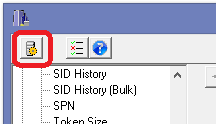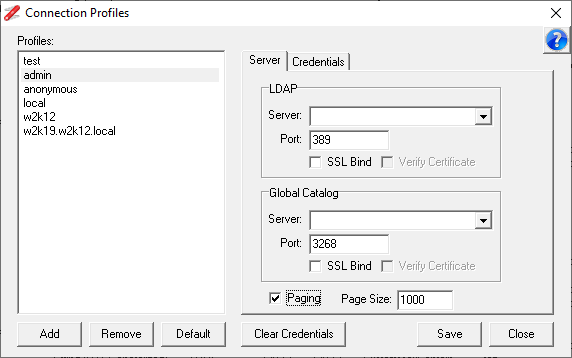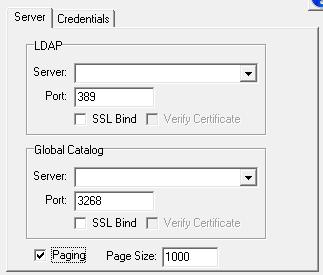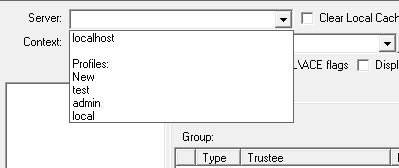
By default NetTools will use the domain the workstation is joined to define the AD it talks to and the user context that NetTools is executed under to provide the credentials used to access the AD. In most case this is sufficient, however, there are a number of scenario where you might want to connect to different AD or use a different set of credentials, Connection Profiles provide this ability.
Multiple Connection Profiles can be defined, these can be used to select different domains, specify the domain controller, different credentials, different authentication method, AD paging and page size, or SSL binds. Once Connection Profiles are defined they can be selected on per feature basis or a Connection Profile can be set as default and that Connection Profile will be used if no server or profile is selected.
If no profiles are defined then NetTools will continue to use the default domain of the workstation and credentials of the user context executing NetTools when connecting the AD.
The Connection Profiles dialog is access via the toolbar:
This is the Connection Profiles dialog
New profiles are created click on the Add button, you will be prompted to enter a name for the new profile. Once a profile is selected the Server and Credentials options will be enabled.
The Remove button will delete the selected profile.
The Default button is used to select which profile will be used by default if the Server field on the NetTools feature is left blank. If the selected profile is already set to be the default profile, clicking Default again will be cleared as the default.
The Clear Credentials button is used to clear cached passwords, and next time a profiles that prompts for a password is used, you will be prompted to provide the password.
The Save button is used to save any changes made to the profile, if you forget to save changes when changing between profiles or closing the dialog you will be prompted to save your changes.
The Server tab defines the connection details to the AD and the connection type to be used.
The LDAP and Global Catalog sections are used to define the which server is used for each connection type. The GC details are used by the User Search option and AD properties dialog
The Server field specifies the name of the server that NetTools will connect to. If the AD being accessed is the same AD as the workstation is joined to, this can be blank and NetTools will use the default AD name resolution to find a domain controller. Or it can be the FQDN of the AD domain and forest, and as a long as name can be resolved, it will connect.
By default the Port is set to 389 for LDAP and 3268 for GC, this can be changed to reflect the requirements of the AD, AD LDS or LDAP directory you are connecting to.
The SSL Bind specifies if the connection will use SSL encryption for the traffic, when SSL Bind is selected the Port will automatically change to 636 or 3269, however, this can be changed if required.
The Verify Certificate option defines if the server certificate that is used during the bind is validated or not, with this option selected the certificate is validated by the default Microsoft revocation process. When this option is not selected the certificate is not verified and the certificate is accept without any form of validation, and a certificate with issues will also be accepted.
The Paging option define if the paging server side control is used when performing queries against the AD. If this option is not selected then the number of items returned will be limited to MaxPageSize entry as defined the Query Policy applied to the domain controller. The Page Size defines the number of records that will be returned in each page request. It's recommended to leave Paging enabled when connecting to Microsoft AD or AD LDS directories.
The Bind Type specifies the bind method and if credentials are required.
The Current user's credentials option will use the LDAP_AUTH_NEGOTIATE authentication method and the current credentials used to execute NetTools.
The Bind with Credentials option will bind with the LDAP_AUTH_NEGOTIATE authentication method and use the credentials provided in the Credentials section
The Advanced Bind type option allow you to specify the bind\authentication method that will be used when connecting to the directory. The available bind types are listed below, some of which may require additional security packages to be installed for them to be used:
LDAP_AUTH_SIMPLE this method requires the DN of the account and password, domain is not required
LDAP_AUTH_DIGEST Digest authentication package
LDAP_AUTH_DPA Distributed password authentication. Used by Microsoft Membership System
LDAP_AUTH_MSN Microsoft Network Authentication Service
LDAP_AUTH_NTLM this method uses NTLM to authenticate against the directory
LDAP_AUTH_SICILY covers package negotiation to MSN servers
LDAP_AUTH_DIGEST this method requires the samaccountname and password
LDAP_AUTH_NEGOTIATE this method requires either, samaccountname or UPN and password, the domain is optional
ANONYMOUS the username and password are not required
The Credentials options are enabled based on the Bind Type selection and provide the ability to specify different Credentials.
Passwords
NetTools doesn't save passwords to permanent storage, they are only cached in memory for the duration that NetTools is running. In the Connection Profiles, there is no option to enter the password, if a password is required then the Prompt for Password option must be selected. Then when the profile is used and a password is required, you will be prompted to provide the password (the dialog below will be displayed). The password provided is encrypted and stored in memory and the cached password will be used if the profile is used again. If the password entered causes an invalid credential error when connecting to the server, the cached password is cleared and you will be prompted to enter the password again the next time the profile is used.
When a profile is changed and saved, the cached password associated to the profile is cleared and you will be prompted for the password when the profile is next used.
You can use the Clear Credentials button to clear the password associated to all profiles.
Using Connection Profiles
Once the Connection Profiles have been created, you can select the required profile from the server or domain field dropdown lists on each of the NetTools Options. The servers or domains that have been saved are displayed first, then under the Profiles tag, the list of profiles are displayed. If default profile has been setup, then if the server field is left blank then the default profile will be used. In the screenshot below the Profiles: New, Test, admin, and local are displayed.
The following NetTools options do not uses Connection Profiles:
-
-
-
- DsGetDcName
- LDAP Ping
- LSA Trust
- NetGetDcName
- Replication Latency
-
-
A number of the NetTools functions use the DSBind function to connect to AD, this function doesn't support the use of an IP address for the server name, and will fail with error 87, invalid parameter. The following functions use DSBind:
-
-
-
- DC Resolution
- SID History
- SID History Bulk
-
-





